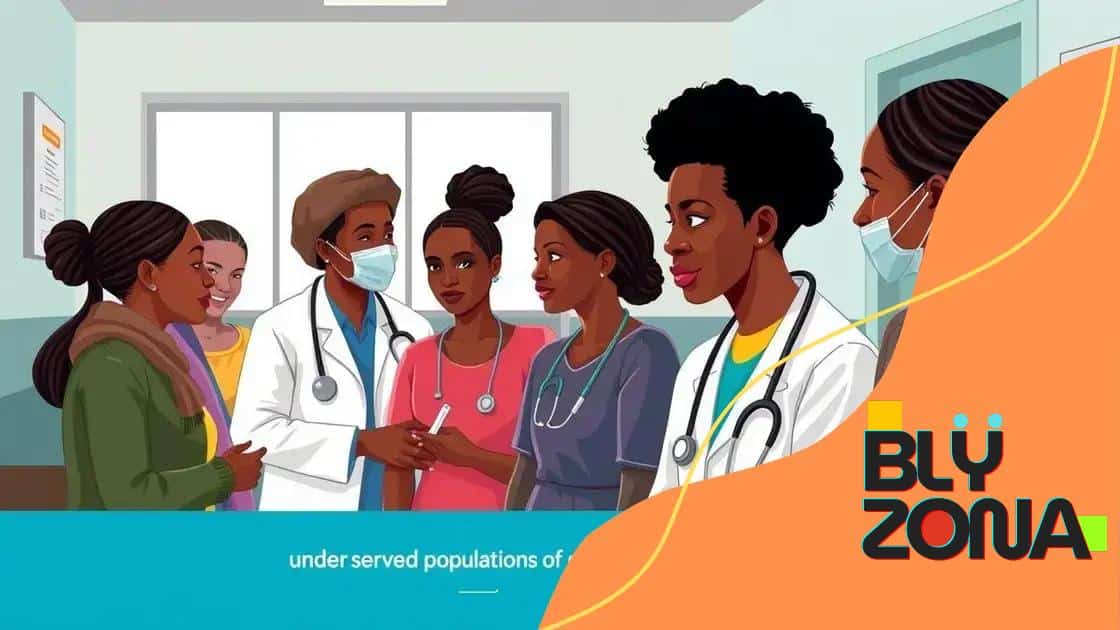The future of Medicaid expansion under new legislation

The future of Medicaid expansion in America is characterized by potential increased access for low-income individuals, driven by technological advancements and a focus on reducing health disparities, despite ongoing financial and political challenges.
The future of Medicaid expansion under new legislation holds significant importance for many Americans. With recent shifts in policies, it’s essential to understand how these changes might affect access to healthcare. Have you considered how this could impact you or your loved ones?
Understanding Medicaid expansion
To grasp Medicaid expansion, we must start by understanding its purpose and importance. This initiative aims to provide healthcare coverage to millions who otherwise may not have access. By expanding eligibility, states can help low-income individuals and families gain crucial health services.
What is Medicaid Expansion?
Medicaid expansion is part of the Affordable Care Act (ACA), designed to broaden the scope of Medicaid. Initially launched in 2010, the ACA allowed states the option to expand Medicaid to cover more residents. This decision, while optional, has significant implications for overall health outcomes.
Benefits of Medicaid Expansion
The benefits of Medicaid expansion are widely recognized. Firstly, it increases healthcare access for low-income families. Additionally, it reduces the number of uninsured individuals. Here are some key benefits:
- Improved access to medical care.
- Increased preventive services utilization.
- Reduction in hospital uncompensated care costs.
Furthermore, Medicaid expansion enables states to draw down additional federal funds, which can boost local healthcare systems and economies.
Who is Affected?
Medicaid expansion significantly impacts various groups. Low-income adults are the most directly affected, as they often lack affordable health insurance options. Families with children, individuals with disabilities, and the elderly also stand to benefit from expanded coverage.
In many communities, Medicaid expansion serves as a lifeline, preventing medical bankruptcies and ensuring that families can access necessary services. As states implement these changes, the face of healthcare continues to evolve, presenting both challenges and opportunities.
In closing, understanding Medicaid expansion is crucial for recognizing its role in the healthcare landscape. As more states debate its adoption, the potential positive impacts for vulnerable populations become increasingly clear.
Key legislative changes and their implications
Recent legislative changes have significantly shifted the landscape of Medicaid expansion. Understanding these changes is essential for grasping their potential effects on individuals and communities. One key aspect is how different states respond to federal incentives and guidelines, which can drastically alter the number of people covered by Medicaid.
Overview of Major Legislative Changes
The expansion of Medicaid under the Affordable Care Act was a landmark decision, leading to numerous state-level adjustments. Each state has the freedom to accept or decline this expansion, resulting in a patchwork of coverage across the country. This leads to varied healthcare access depending on state decisions.
Implications for States
States that choose to expand Medicaid can experience several immediate benefits. These include:
- Receiving additional federal funding for healthcare services.
- Lowered rates of uninsured individuals.
- Enhanced services for low-income populations.
However, states that opt out of expansion may see increased healthcare costs in other areas. Emergency rooms often become the treatment center for uninsured individuals, leading to financial strain on local hospitals and increased taxpayer burdens.
Political and Social Impacts
The political atmosphere surrounding these legislative changes can greatly influence public opinion and health policy. Advocacy groups often push for expansion, arguing that it provides essential support for vulnerable populations. Additionally, expanding Medicaid can help reduce health disparities among various demographic groups.
Moreover, as Medicaid evolves with each new piece of legislation, it brings forth discussions on healthcare equity. The social implications of these policies stretch far beyond immediate health coverage, affecting economic stability and overall community well-being. These ongoing debates highlight the importance of staying informed about how the legislative climate impacts healthcare access.
Ultimately, monitoring key legislative changes and their implications is critical. As policy decisions continue to unfold, they will shape the healthcare landscape for years to come, influencing who gets covered and how services are delivered.
Benefits of Medicaid for underserved populations

The benefits of Medicaid for underserved populations are vast and critical. Many individuals in low-income brackets struggle to access necessary healthcare services. Medicaid serves as a crucial safety net, providing health coverage to those who would otherwise go without care.
Access to Essential Health Services
One of the primary benefits of Medicaid is that it increases access to essential health services. When individuals receive coverage through Medicaid, they can seek preventive care, such as regular check-ups and screenings. This access is key to catching health issues early and managing chronic conditions effectively.
Financial Protection
Medicaid also offers significant financial protection to low-income families. It reduces out-of-pocket costs, enabling individuals to receive necessary care without the fear of overwhelming debt. This financial relief is vital for maintaining family stability and overall well-being.
By eliminating barriers to primary and preventive care, Medicaid helps improve health outcomes for underserved populations. This ultimately leads to healthier communities where individuals can work, thrive, and contribute to society.
Support for Vulnerable Groups
Medicaid is particularly beneficial for vulnerable groups, including children, the elderly, and those with disabilities. These populations often face more significant health challenges and require specialized care. Medicaid provides a bridge to vital services, ensuring that these individuals have access to medically necessary treatments.
- Children enrolled in Medicaid programs receive regular immunizations.
- Elderly individuals gain access to long-term care services.
- Individuals with disabilities can secure essential therapies and support.
Moreover, the support that Medicaid offers can foster better health equity, particularly in communities that traditionally lack care options.
In summary, understanding the benefits of Medicaid for underserved populations unveils its importance as a safeguard for those in need. By facilitating access to quality healthcare, Medicaid plays a transformative role in improving the health and well-being of society as a whole.
Challenges facing Medicaid expansion efforts
Despite the potential benefits of Medicaid expansion, several challenges hinder its implementation across various states. Understanding these challenges is essential for anyone interested in healthcare policy and reform. States grapple with a host of logistical, financial, and political issues that impact their choices regarding Medicaid.
Financial Concerns
One of the most significant challenges is the financial burden associated with Medicaid expansion. While the federal government covers a large portion of the costs, some states worry about the long-term sustainability of funding. There is a fear that they will eventually have to shoulder more expenses as federal support diminishes over time.
Political Resistance
Political resistance also plays a crucial role in hindering Medicaid expansion. In many states, lawmakers are divided along party lines, with some opposing expansion for ideological reasons. This resistance is especially strong in states where the political climate is less supportive of increased government involvement in healthcare.
Public Perception and Misinformation
Public perception can also affect the momentum for Medicaid expansion. In some cases, misinformation surrounding the program creates fear and uncertainty among constituents. Myths about cost, eligibility, and services can lead to public opposition to expansion efforts.
Furthermore, there is also concern about the overwhelmed healthcare infrastructure in certain areas. Expanding Medicaid could lead to increased demand for services, placing additional strain on already stretched healthcare providers. This challenge often dissuades states from moving forward.
Complexity of Implementation
Finally, the complexity of implementing Medicaid expansion adds another layer of difficulty. Each state has unique needs and systems that must be considered. The administrative burden can be daunting, and many states lack the resources to effectively manage the transition.
As these challenges surface, it becomes clear that the path to Medicaid expansion is not straightforward. Awareness and understanding of these issues are crucial for advocates and policymakers aiming to improve healthcare access for all.
Future outlook for Medicaid in America
The future outlook for Medicaid in America is an important topic that affects millions of Americans. As healthcare needs evolve, so do the policies surrounding Medicaid. Many experts believe that ongoing discussions at both state and federal levels will influence the trajectory of Medicaid expansion and its implementation.
Potential for Further Expansion
Many states are considering or have begun to implement their own versions of Medicaid expansion. This trend may continue as policymakers recognize the benefits of providing coverage to low-income individuals. States that expand Medicaid can expect increased federal funding, which can help strengthen their healthcare systems.
Technological Advancements
Another significant factor shaping the future of Medicaid is the integration of technology into healthcare. Advances in telemedicine and digital health tools can enhance access to care and efficiency in service delivery. With more people utilizing technology for health services, Medicaid can adapt to meet these changing needs.
Moreover, the ongoing emphasis on value-based care may transform how Medicaid programs operate. Focusing on patient outcomes rather than services rendered could lead to more effective and cost-efficient healthcare.
Addressing Health Disparities
As discussions about health equity grow, the future of Medicaid will likely focus on addressing health disparities. Policymakers may develop initiatives aimed at ensuring that underserved populations receive the care they need. Improving access for marginalized communities is paramount for achieving overall health improvements across the nation.
However, challenges remain, including political resistance and funding concerns. States will need to navigate these hurdles to ensure that Medicaid continues to play a vital role in healthcare access. With the right strategies and support, the future of Medicaid can offer improved health outcomes for millions.
FAQ – Frequently Asked Questions about Medicaid Expansion
What is Medicaid expansion?
Medicaid expansion refers to the process of broadening the eligibility criteria for Medicaid, enabling more low-income individuals and families to access healthcare coverage.
How does Medicaid benefit underserved populations?
Medicaid provides essential health services, reduces financial burden, and improves health outcomes for vulnerable groups like low-income families, children, and individuals with disabilities.
What challenges does Medicaid expansion face?
Key challenges include financial concerns, political resistance, public misconceptions, and the complex logistics involved in implementing the expansion.
What is the future outlook for Medicaid in America?
The future of Medicaid is shaped by potential expansion, technological advancements, and efforts to address health disparities, although political dynamics will also play a significant role.





